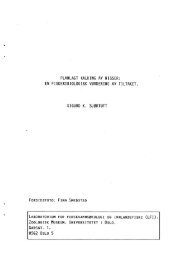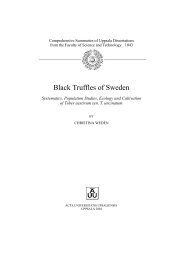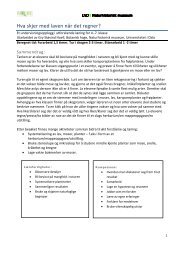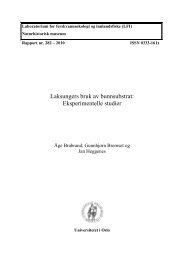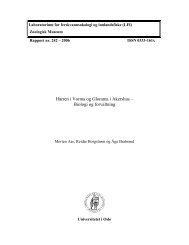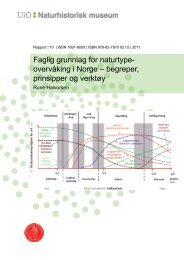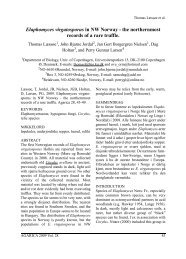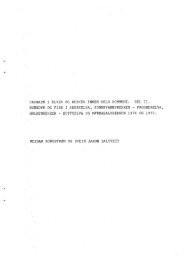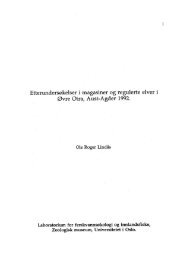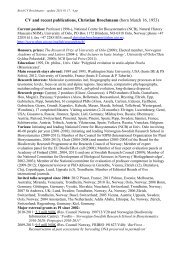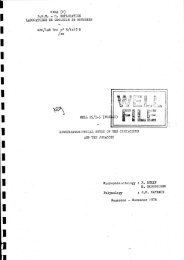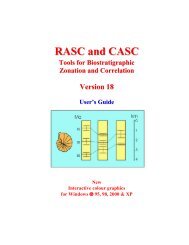Truffle trouble: what happened to the Tuberales?
Truffle trouble: what happened to the Tuberales?
Truffle trouble: what happened to the Tuberales?
- TAGS
- truffle
- www.nhm.uio.no
You also want an ePaper? Increase the reach of your titles
YUMPU automatically turns print PDFs into web optimized ePapers that Google loves.
1076 T. Læssøe, K. Hansen<br />
Pezizales and just Elaphomyces <strong>to</strong> <strong>the</strong> Elaphomycetales. Fischer<br />
(1897) had earlier referred Elaphomyces <strong>to</strong> <strong>the</strong> ‘Plectascineae’<br />
but alongside <strong>the</strong> Terfeziaceae. Later (Fischer 1938), Terfeziaceae<br />
reappeared within <strong>the</strong> <strong>Tuberales</strong>. Trappe (1979) kept some hypogeous<br />
lines, as families, within his Pezizales, but o<strong>the</strong>r hypogeous<br />
taxa were placed alongside epigeous species in various<br />
mixed families. Burdsall (1968) had already convincingly<br />
merged one tuberalean genus (Geopora) with <strong>the</strong> pezizalean<br />
genus Sepultaria. Eckblad (1968) gave many clear arguments<br />
for not accepting <strong>the</strong> <strong>Tuberales</strong> but, never<strong>the</strong>less, concluded<br />
<strong>the</strong> opposite. In <strong>the</strong> first Outline of <strong>the</strong> Ascomycetes (Eriksson<br />
1982) <strong>Tuberales</strong> (with Geneaceae, Terfeziaceae, and Tuberaceae)<br />
were relegated <strong>to</strong> synonymy of Pezizales. Ainsworth & Bisby’s<br />
Dictionary of <strong>the</strong> Fungi (Hawksworth 1983) likewise abandoned<br />
<strong>the</strong> use of <strong>Tuberales</strong> and listed <strong>the</strong> order under Pezizales (and<br />
Elaphomycetales). Trappe’s hypo<strong>the</strong>sis was tested in a longlasting<br />
study of <strong>the</strong> ultrastructure of pezizalean taxa guided<br />
by Kimbrough and summarized in Kimbrough (1994), that<br />
for example, led <strong>to</strong> <strong>the</strong> placement of Hydnobolites in <strong>the</strong> Pezizaceae,<br />
based on both cy<strong>to</strong>logical and ultrastructural features of<br />
asci and ascospores. Also <strong>the</strong> placement of Barssia in <strong>the</strong> Helvellaceae<br />
followed from <strong>the</strong>se studies. The most important<br />
character used was <strong>the</strong> morphology of <strong>the</strong> complicated septal<br />
pore-apparatus at <strong>the</strong> base of <strong>the</strong> asci (Kimbrough 1994). Ano<strong>the</strong>r<br />
prominent feature, <strong>the</strong> number of nuclei in <strong>the</strong> mature<br />
spores that originated in Ber<strong>the</strong>t’s (1963) studies on epigeous<br />
Pezizales, was also taken in<strong>to</strong> account when trying <strong>to</strong> delimit<br />
natural groups of truffles (e.g. Ber<strong>the</strong>t 1982; Donadini 1986a,<br />
b). With <strong>the</strong> onset of <strong>the</strong> molecular taxonomy era, <strong>the</strong>se early<br />
hypo<strong>the</strong>ses have gradually been confirmed and expanded<br />
upon, or in some cases, corrected (e.g. O’Donnell et al. 1997;<br />
Norman & Egger 1999; Percudani et al. 1999; Hansen et al.<br />
2005; Perry et al. 2007). In a comprehensive treatment of European<br />
(mainly Italian) truffles Montecchi & Sarasini (2000) refer<br />
former <strong>Tuberales</strong> taxa <strong>to</strong> Elaphomycetales, with just Elaphomyces,<br />
and Pezizales with seven families: Pezizaceae (four genera),<br />
Pyronemataceae (four genera), Geneaceae (two genera), Helvellaceae<br />
(three genera), Balsamiaceae (two genera), Terfeziaceae<br />
(four genera) and Tuberaceae with two genera. Although, <strong>the</strong>y<br />
cite recent molecular results, <strong>the</strong>y have chosen a conservative<br />
approach by following <strong>the</strong> systems proposed in Trappe (1979)<br />
and Pegler et al. (1993). One group of researchers (Parguey-<br />
Leduc et al. 1987b, 1990; Janex-Favre & Parguey-Leduc 2003)<br />
proposed <strong>to</strong> accept <strong>Tuberales</strong> based mainly on <strong>the</strong> genera Tuber<br />
and Terfezia that were considered closely related, mostly<br />
based on a perceived different development of asci and ascospores.<br />
van Brummelen (1994) gave a summary of <strong>the</strong> arguments<br />
put forward up <strong>to</strong> that time. Eriksson (2006b),<br />
influenced by data published by e.g. de Hoog et al. (2005), discussed<br />
<strong>what</strong> <strong>to</strong> do nomencla<strong>to</strong>rily if Pezizales are restricted<br />
<strong>to</strong> Pezizaceae. Although <strong>Tuberales</strong> are a possible choice, he proposed<br />
<strong>to</strong> find ano<strong>the</strong>r name. Currently, however, <strong>the</strong>re is no<br />
supported molecular phylogenetic evidence that suggests<br />
Pezizaceae are not part of <strong>the</strong> Pezizales (<strong>the</strong> Pezizaceae are supported<br />
as monophyletic by a BS value of 100 %, but <strong>the</strong> relationships<br />
among <strong>the</strong> included families in e.g. de Hoog et al.<br />
(2005) are without support).<br />
The purpose of this paper is <strong>to</strong> review morphological and biological<br />
traits, and <strong>the</strong> systematics of <strong>the</strong> passively dispersed,<br />
more or less hypogeous Pezizales. Using all currently available<br />
LSU sequences from pezizalean truffles, in analyses with<br />
a broad sample of epigeous pezizalean taxa, we will fur<strong>the</strong>r investigate<br />
<strong>the</strong> phylogenetic relationships and evolution of <strong>the</strong>se<br />
truffle fungi. Ascomyce<strong>to</strong>us truffles, which are now considered<br />
<strong>to</strong> be non-pezizalean (Elaphomyces, Eurotiomycetes), are not<br />
treated in detail. The taxonomic position of all accepted taxa<br />
at and above generic level are given and compared with previous<br />
classifications. The accepted classification is based on molecular<br />
phylogenetic analyses and morphological characters.<br />
A truffle definition<br />
Ascomycete truffles can be defined as producing sporocarps<br />
below or at ground level and with a simultaneous loss of active<br />
spore dispersal. In several genera, for example Geopora and<br />
Helvella, species with intermediate characters can be found.<br />
Also Sarcosphaera coronaria is an example of a fungus that<br />
has nearly become a truffle. It forms apo<strong>the</strong>cia below ground<br />
and often opens by a ra<strong>the</strong>r small aperture, but as <strong>the</strong> spores<br />
are actively ejected it can still be classified as a ‘‘cup fungus’’.<br />
The genus Caulocarpa was based on such hypogeous Sarcosphaera<br />
ascomata (Trappe 1975c). Although some species tend<br />
<strong>to</strong> produce sporocarps in or on <strong>the</strong> litter, we still group <strong>the</strong>m<br />
with <strong>the</strong> truffles as long as <strong>the</strong>y have lost active spore dispersal.<br />
Glaziella and Paurocotylis are good examples.<br />
Morphological features of pezizalean truffles<br />
The ascomata are typically fleshy but can be quite hard and<br />
cartilaginous. An outer rind (peridium) is often present and<br />
can be almost woody and sculptured. Even at maturity <strong>the</strong><br />
spores do not become powdery, except in a few genera (e.g.<br />
Carbomyces) that are adapted <strong>to</strong> extreme xeric conditions.<br />
There is a continuous variation from truffles with a single cavity<br />
lined with a hymenium, often with a single opening, <strong>to</strong><br />
truffles with intricate foldings or with pockets of asci in<br />
a firm gleba. Weber et al. (1997) defined three different types<br />
of hypogeous ascomata within <strong>the</strong> Pezizales: ptycho<strong>the</strong>cia<br />
with persistent, recognizable hymenia and variously folded<br />
or even solid ascomata; stereo<strong>the</strong>cia without hymenia and<br />
solid ascomata; and exo<strong>the</strong>cia with external hymenia. None<br />
of <strong>the</strong>se ascoma types can accommodate Paurocotylis and<br />
Glaziella. These genera produce ascomata that are hollow,<br />
without paraphyses, and fur<strong>the</strong>rmore, are unusual in being<br />
fully exposed at maturity. Hansen et al. (2001) reviewed <strong>the</strong><br />
morphological features of <strong>the</strong> truffles considered <strong>to</strong> belong<br />
<strong>to</strong> <strong>the</strong> Pezizaceae. Those pezizalean species that have been<br />
studied in on<strong>to</strong>genic detail, such as Tuber and Terfezia species<br />
(Janex-Favre & Parguey-Leduc 2003), start out as apo<strong>the</strong>cial<br />
before folding occurs. The asci can at one end of <strong>the</strong> variation<br />
resemble those of operculate species being cylindrical with<br />
spores in one row or at <strong>the</strong> o<strong>the</strong>r end be completely globose<br />
with or without a pedicel and with a variable number of often<br />
very large spores. The ascospores vary in colour from hyaline<br />
<strong>to</strong> almost black, and in surface features from smooth and<br />
thin-walled <strong>to</strong> very thick-walled with intricate ornamentation.<br />
The ascus walls can be more or less layered and amyloid<br />
or inamyloid. The Pezizaceae are characterized by amyloid asci,<br />
but this feature appears <strong>to</strong> have been lost in many pezizaceous<br />
truffles (Hansen et al. 2001, 2005).



